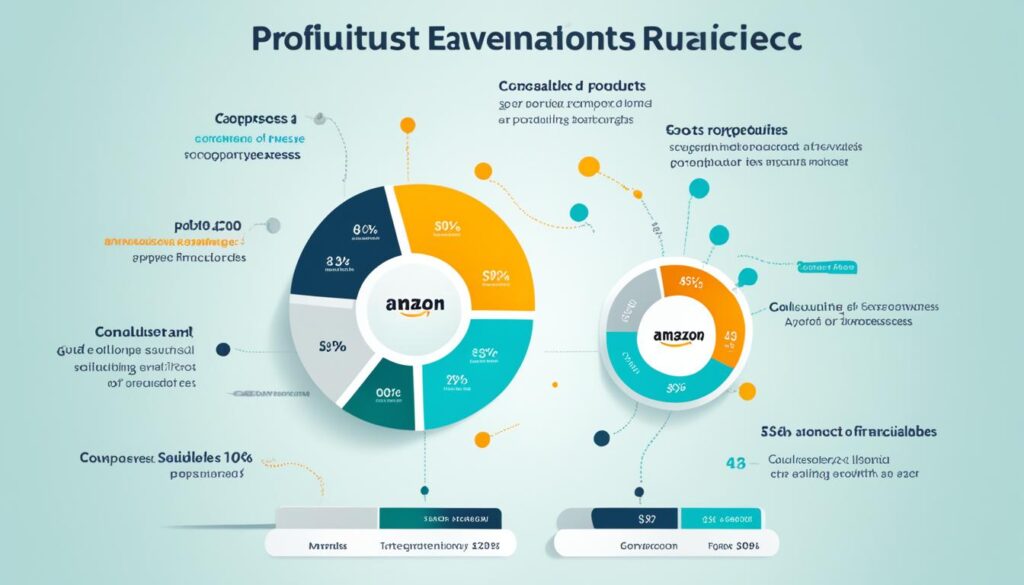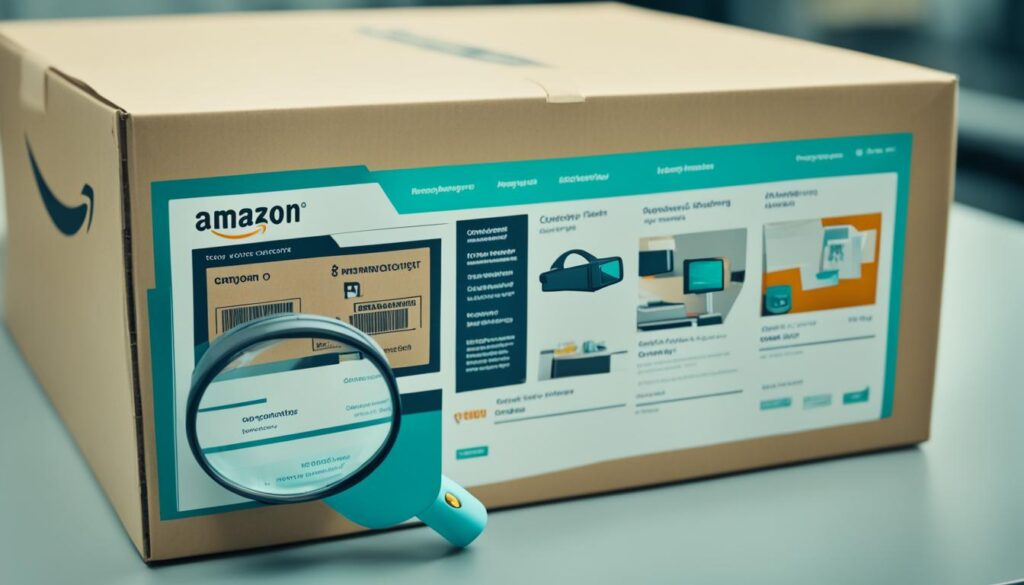Amazon product research is crucial for success as an Amazon seller. By finding profitable products, understanding market trends, and evaluating competition, you can make informed business decisions that will help boost your Amazon seller success. With the right tools and strategies, you can identify niche products with high demand and low competition, giving you a competitive advantage in the Amazon marketplace. In this comprehensive guide, we will explore the best strategies and tools for Amazon product research, covering everything from finding product ideas to analyzing market trends and evaluating profitability. Whether you’re a new seller or an experienced one looking to expand your product offerings, this guide will provide you with the knowledge and resources you need to succeed in Amazon product research.
Key Takeaways:
- Amazon product research is essential for success as an Amazon seller.
- By understanding market trends and evaluating competition, you can make informed business decisions.
- Identify niche products with high demand and low competition for a competitive advantage.
- Utilize tools and strategies to find profitable product ideas and analyze market trends.
- Consider factors such as profitability, target market, and differentiation when selecting products to sell on Amazon.
The Importance of Target Market Research
Before diving into Amazon product research, or private label research, it’s essential to have a clear understanding of your target market. Knowing who your potential customers are and what they are looking for will help you identify the types of products that will cater to their needs and preferences.
Conducting target market research involves analyzing demographics, purchasing behavior, and pain points of your ideal customers. This information will guide your product selection process and help you stand out in the crowded Amazon marketplace.
By catering to the specific needs of your target market, you can create a niche for your products and increase your chances of success as an Amazon seller.
Target market research is crucial for finding the right products that will resonate with your customers and set you apart from the competition in the Amazon marketplace.
Why Target Market Research Matters:
- Identify customer demographics: Understand who your customers are in terms of age, gender, location, and other relevant factors.
- Analyze purchasing behavior: Gain insights into how your customers shop, what motivates their buying decisions, and their preferred shopping channels.
- Identify pain points: Discover the challenges and problems your customers face, and how your products can offer solutions.
- Discover market trends: Stay updated on the latest trends and shifts in consumer behavior to ensure your product offerings remain relevant.
- Create targeted marketing strategies: Tailor your marketing messages and promotional efforts to effectively reach your target audience.
“By understanding your target market, you can make informed decisions about the products you offer and position yourself as the go-to seller for their specific needs.” – Jane Smith, Amazon Seller
By investing time and effort into target market research, you can optimize your product selection process and increase your chances of success in the Amazon marketplace.
Benefits of Target Market Research
| Benefits | Explanation |
|---|---|
| Identify customer needs | Understand what products your customers are looking for and create offerings that meet their specific needs. |
| Reduce competition | By catering to a specific target market, you can differentiate yourself from competitors and carve out a niche for your products. |
| Improve marketing efforts | Knowing your target market enables you to create tailored marketing messages and promotions that resonate with your customers. |
| Increase customer satisfaction | By offering products that align with your customers’ preferences, you can enhance their satisfaction and loyalty. |
Leveraging Amazon’s Best Sellers Lists for Product Ideas
Amazon’s Best Sellers lists are a treasure trove of valuable information for Amazon sellers. These lists provide insights into the products that are currently popular among Amazon customers, giving you a glimpse into emerging trends and seasonal items that might be worth exploring. By analyzing the top-selling products, you can identify what’s in demand and what customers are loving.
When browsing through Amazon’s Best Sellers lists, pay close attention to products with high sales volumes and exceptional customer reviews. These indicators suggest real-time demand and satisfied customers, making them prime opportunities for your Amazon product research. These best-selling products can serve as inspiration for developing your own unique ideas or finding potential niches to explore.
“Amazon’s Best Sellers lists are like windows into the minds of customers. By understanding what’s selling well, you can gain valuable insights into market trends and consumer preferences.” – Amazon Seller
However, it’s important to exercise caution when considering products from highly competitive categories. While high sales volumes might seem attractive, aggressive competition can make it challenging to succeed. Take the time to analyze the competition and identify opportunities where you can offer a unique selling proposition that sets your products apart.
Identifying Emerging Trends and Niche Opportunities
Amazon’s Best Sellers lists not only showcase popular products, but they also unveil emerging trends and niche opportunities. By studying these lists, you can identify product categories that are gaining traction and explore potential markets that haven’t been fully saturated.
Keep an eye out for products that align with emerging consumer preferences, such as sustainable or eco-friendly options. These trends can help you stay ahead of the curve and tap into growing market demands.
Competition Analysis and Unique Selling Proposition
As an Amazon seller, competition analysis is crucial for your success. Analyzing the top-selling products on Amazon can give you insights into what’s already dominating the market. By understanding the competition, you can find ways to differentiate your products and offer a unique selling proposition.
Consider aspects like product features, packaging, pricing, and customer reviews to find areas where you can stand out. Focus on delivering exceptional value, improving product quality, or targeting specific customer segments that may be underserved.

By leveraging Amazon’s Best Sellers lists, you can gain valuable insights into popular products, emerging trends, and competition analysis. These insights can inform your product research and help you identify profitable opportunities in the Amazon marketplace.
Utilizing AI-Powered Research Tools for Data-driven Decisions
Artificial intelligence and machine learning have revolutionized the field of Amazon product research. With the advent of AI-powered research tools, such as Helium 10 and Jungle Scout, Amazon sellers now have access to advanced market analysis, keyword research, and competitor analysis capabilities.
These powerful tools harness the power of AI algorithms to deliver valuable data and insights that can guide informed decision-making in Amazon product research. By leveraging these tools, sellers can analyze highly-searchable keywords, study sales data, and understand market trends to identify profitable product opportunities and gain a competitive edge in the Amazon marketplace.
Market analysis features offered by AI-powered research tools enable sellers to evaluate current market conditions, consumer preferences, and emerging trends. By assessing this data, sellers can uncover untapped niche markets and make informed decisions on which products to pursue.
Keyword research is another crucial aspect of Amazon product research, and AI-powered tools provide comprehensive keyword analysis that helps sellers optimize product listings and boost visibility on Amazon search results pages. By identifying high-volume, low-competition keywords, sellers can increase their chances of reaching their target audience and driving more organic traffic to their product listings.
In addition to market and keyword analysis, AI-powered research tools also offer robust competitor analysis capabilities. Sellers can gain insights into their competitors’ product offerings, pricing strategies, sales volumes, and customer reviews. Armed with this information, sellers can devise effective strategies to differentiate their products, offer unique value propositions, and outperform their competitors.
Using AI-powered research tools empowers sellers to make data-driven decisions and minimize the guesswork involved in Amazon product research. By harnessing the capabilities of these powerful software solutions, sellers can achieve higher levels of success in their Amazon business and maximize their profitability.
Comparison of AI-powered Research Tools
| Research Tool | Market Analysis | Keyword Research | Competitor Analysis |
|---|---|---|---|
| Helium 10 | ✅ | ✅ | ✅ |
| Jungle Scout | ✅ | ✅ | ✅ |
| SellerApp | ✅ | ✅ | ✅ |
These AI-powered research tools offer various features and functionalities to assist Amazon sellers in their Amazon product research journey. Each tool excels in market analysis, keyword research, and competitor analysis, providing sellers with a comprehensive suite of insights and data to fuel their success. By carefully evaluating these tools based on individual needs and preferences, sellers can select the one that best suits their requirements and unlocks the full potential of their Amazon business.
Calculating Product Profitability and Evaluating Costs
Profit margin plays a crucial role in the success of your Amazon business. When conducting Amazon product research, it’s essential to evaluate the estimated product profitability by analyzing various costs, including manufacturing costs, shipping fees, Amazon referral fees, and FBA fees. By deducting these costs from the selling price, you can determine the potential profitability of the product.
Conducting a comprehensive cost analysis is imperative to make informed business decisions. Consider factors such as return rates and customer support requirements that might impact profitability. By understanding the costs associated with your products, you can choose wisely and select those that offer a profitable opportunity.
“When evaluating product profitability, don’t overlook the hidden expenses such as import and export fees.”
Manufacturing Costs:
- Calculate the costs associated with producing or sourcing the product, including raw materials, labor, and manufacturing overhead.
- Consider factors such as minimum order quantities, lead times, and potential production delays that may affect costs.
Shipping Fees:
- Assess the costs of shipping the product from your supplier to Amazon’s fulfillment centers.
- Consider different shipping methods, carrier options, and any additional fees, such as customs duties or warehousing charges.
Amazon Fees:
- Evaluate Amazon referral fees, which are a percentage of the item price that Amazon charges to list and sell your product.
- Account for FBA fees, including storage fees, pick and pack fees, and fulfillment fees, if you plan on utilizing Amazon’s fulfillment services.
“Accurate cost analysis is the lifeline of a profitable business.”
By diligently considering all the relevant costs associated with your products, you can make informed decisions that maximize your product profitability. Ensure you factor in any potential variations in costs and regularly review and adjust your analysis as needed to adapt to market changes, optimize profitability, and drive the success of your Amazon business.

Creating Bundles for Increased Sales and Differentiation
Product bundling is a powerful strategy that can significantly boost your sales and help you stand out in the competitive Amazon marketplace. By offering complementary products as a bundle, you can provide customers with added value and convenience, encouraging them to make larger purchases and increasing your average order value.
Bundling products allows you to create unique offerings that cater to a specific target audience. When researching potential bundles, consider products that naturally complement each other and align with the needs and preferences of your target customers. By combining products that go well together, you create a distinct offering that sets you apart from competitors.
Bundling offers several advantages for both sellers and customers. Customers appreciate the convenience of purchasing multiple products in one go, saving them time and effort. Additionally, bundling can enhance the perceived value of the products, making customers more willing to pay a higher price.
Benefits of Product Bundling:
- Increased Average Order Value: By bundling products, you encourage customers to purchase more items in a single transaction, resulting in higher average order values.
- Improved Customer Satisfaction: Bundling complementary products provides customers with a convenient and comprehensive solution, enhancing their overall experience.
- Competitive Differentiation: Creating unique bundles sets you apart from competitors and can attract more customers to your Amazon listings.
- Higher Perceived Value: Bundling products allows you to offer a higher perceived value to customers, making them more willing to pay a premium price.
When creating bundles, it’s essential to consider the interests and preferences of your target audience. Analyze customer feedback, reviews, and market trends to identify products that are commonly purchased together or have complementary usage. By understanding your customers’ needs, you can design bundles that offer a clear benefit and fulfill their specific requirements.
Here’s an example of a customer-centric bundle:
| Product Bundle: Outdoor Picnic Set |
|---|
|
This bundle combines essential items for an enjoyable outdoor picnic experience. By offering these products as a bundle, customers can save time and money compared to purchasing each item separately. Additionally, the bundle creates a cohesive and convenient package, making it an attractive option for customers in search of a complete picnic set.
Creating unique bundles requires thoughtful planning and market research. Analyze customer preferences, sales data, and competitor offerings to identify gaps or opportunities in the market. By strategically bundling complementary products and aligning them with customer needs, you can leverage the power of product bundling to increase sales, enhance customer satisfaction, and differentiate your business in the Amazon marketplace.
Validating Product Ideas for Market Viability
Before committing to a product and investing substantial resources, it’s crucial to validate your product ideas for market viability. This involves collecting feedback from potential customers through customer surveys to gauge their interest in your product and identify any potential pain points or concerns.
Customer surveys allow you to directly engage with your target market and gather valuable insights. By asking the right questions, you can gain a deeper understanding of your customers’ needs, preferences, and purchase intent. This feedback will help you refine your product offering and align it more closely with market demand.
Another valuable tool in product validation is Google Trends. By analyzing search interest for your product over time, you can identify any seasonal trends or fluctuations in demand. This data can inform your decision-making process and help you choose products that have long-term potential.
Additionally, a test launch can provide invaluable insights into market response. By releasing a small batch of your product and monitoring sales data and customer feedback, you can gauge its initial reception and make necessary adjustments before fully committing to the product.
This combination of customer surveys, analysis of Google Trends data, and test launches will equip you with the necessary information to validate your product ideas and make informed decisions about their viability in the market.
Take a look at the example table below, which demonstrates how customer surveys and Google Trends data can be utilized for product validation:
| Product | Customer Survey Results | Google Trends Data |
|---|---|---|
| Product A | 79% of respondents expressed interest | Consistent search interest over the past year |
| Product B | Only 42% of respondents showed interest | Dramatic decline in search interest over time |
| Product C | 87% of respondents expressed interest | Significant increase in search interest over the past six months |
Based on the data from customer surveys and Google Trends, it is clear that Product A and Product C show promise in terms of market demand and potential profitability. On the other hand, Product B may not be as viable due to declining interest. By conducting thorough product validation, you can make informed decisions and minimize the risks associated with launching new products.
Optimizing Amazon Product Listings for Higher Rankings
In order to increase visibility and rank higher in Amazon product searches, it is crucial to optimize your product listings through Amazon search engine optimization (SEO) and listing optimization. By enhancing various aspects of your product detail page, including images, product title, key product features, product description, and backend search terms, you can improve your chances of attracting customer attention and driving sales.
1. High-Quality Images
Visuals play a key role in attracting customers and converting sales on Amazon. It is imperative to use high-quality images that effectively showcase your product’s features and benefits. Clear, well-lit, and professionally-captured images can help build trust and give customers a better understanding of your product. Consider using multiple images from different angles and perspectives to provide a comprehensive view of your product.
2. Compelling Product Title
The product title is one of the most important elements of your listing. It should be concise, keyword-rich, and captivating to grab the attention of potential customers. By including relevant keywords in your product title, you improve your chances of appearing in relevant search results. However, avoid keyword stuffing and focus on creating a title that is enticing and informative.
3. Highlight Key Product Features
When crafting your product description, make sure to highlight the key features and unique selling points of your product. Clearly communicate how your product solves customers’ problems or improves their lives. Bullet points or numbered lists can be used to break down the features and make them easy to scan for customers.
4. Persuasive Product Description
Your product description should be well-written, persuasive, and informative. Use compelling language to describe the benefits and advantages of your product. Address any potential concerns or objections customers may have and clearly explain how your product stands out from the competition. Incorporate relevant keywords naturally throughout the description to improve search visibility.
5. Backend Search Terms
Backend search terms are hidden keywords that help improve the discoverability and ranking of your product in Amazon’s search results. These keywords are not visible to customers but are crucial for Amazon’s search algorithm. Research relevant keywords that customers may use to find products like yours and strategically incorporate them in the backend search terms.
6. Test, Analyze, and Optimize
Regularly test different variations of your product listing and analyze their performance. Pay close attention to key metrics such as click-through rates, conversion rates, and sales velocity. Based on the data, optimize your listing by making adjustments to the product title, description, images, or backend search terms to improve your product’s visibility and conversion rates.
By applying these optimization strategies, you can enhance your Amazon product listings and increase your chances of ranking higher in search results. Remember to stay updated with Amazon’s guidelines and best practices to ensure ongoing success with your product listings.
Amazon Product Research Recap
Amazon product research plays a crucial role in achieving success as an Amazon seller. By utilizing effective strategies, utilizing appropriate tools, and leveraging data-driven insights, you can uncover profitable products, stay ahead of market trends, and set yourself apart from competitors. Thorough target market research, analysis of Amazon’s Best Sellers lists, AI-powered research tools, profitability calculations, product validation, listing optimization, and bundling strategies are all essential components of a successful Amazon product research journey.
By following the comprehensive guide and implementing the recommended strategies, you can enhance your Amazon seller success and achieve your business goals. Remember, successful Amazon product research is an ongoing and iterative process. Stay updated with the latest market trends, continuously analyze your competition, and adapt your strategies as needed. With dedication, persistence, and the right approach, you can unlock new opportunities, drive sales, and thrive as an Amazon seller.
So, roll up your sleeves, conduct thorough research, make data-driven decisions, and embark on your journey to Amazon seller success. Good luck!
FAQ
Why is Amazon product research important for success as an Amazon seller?
Amazon product research is crucial for success as an Amazon seller because it helps you find profitable products, understand market trends, and evaluate competition, enabling you to make informed business decisions that can boost your success in the Amazon marketplace.
How can target market research benefit Amazon sellers?
Conducting target market research allows Amazon sellers to analyze demographics, purchasing behavior, and pain points of their target customers. This information helps sellers identify the types of products that will cater to their customers’ needs, stand out in the marketplace, and increase their chances of success.
How can I leverage Amazon’s Best Sellers lists for product ideas?
By browsing through Amazon’s Best Sellers lists and analyzing the top-selling products, you can identify emerging trends, popular items, and seasonal products. Pay attention to high sales volumes and positive customer reviews to gauge real-time demand. However, be cautious about entering highly competitive markets.
What are AI-powered research tools, and how can they help in Amazon product research?
AI-powered research tools like Helium 10 and Jungle Scout provide sophisticated market analysis, keyword research, and competitor analysis. These tools use advanced algorithms and data-driven insights to help sellers identify profitable product opportunities, understand market trends, and gain a competitive edge in the Amazon marketplace.
How can I calculate product profitability and evaluate costs?
To calculate product profitability, consider factors like manufacturing costs, shipping fees, Amazon referral fees, and FBA fees. By subtracting these costs from the selling price, you can determine the potential profitability of a product. It’s important to analyze all relevant costs and factors that may impact profitability, such as return rates and customer support requirements.
How can I increase sales and differentiate myself through product bundling?
Product bundling is an effective strategy for increasing average order value and standing out in the Amazon marketplace. By offering complementary products as a bundle, you provide customers with added value and convenience, potentially leading to increased sales. Consider products that naturally pair well together and cater to a similar target audience.
How can I validate my product ideas before committing to them fully?
Validate your product ideas by collecting feedback from potential customers through surveys, analyzing Google Trends data for search interest, and conducting a test launch with a small batch of your product. This information helps you gauge customer interest, identify potential pain points, and optimize your product offering before fully committing to it.
How can I optimize my Amazon product listings for higher rankings?
To optimize your Amazon product listings, enhance every aspect of your product detail page, including images, product title, key product features, product description, and backend search terms. Use high-quality images, create a compelling product title with relevant keywords, highlight key product features, and write a persuasive product description. Select backend search terms carefully to improve discoverability and ranking in Amazon’s search results.
What is the importance of Amazon product research for Amazon sellers?
Amazon product research is a critical process for success as an Amazon seller. By using the right strategies, tools, and data-driven insights, you can identify profitable products, understand market trends, and differentiate yourself from the competition. Thorough Amazon product research enhances your chances of success and helps you achieve your business goals on Amazon.




